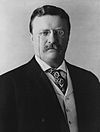L. M. Shaw | |
|---|---|
 | |
| 43rd United States Secretary of the Treasury | |
| In office February 1, 1902 – March 3, 1907 | |
| President | Theodore Roosevelt |
| Preceded by | Lyman J. Gage |
| Succeeded by | George B. Cortelyou |
| 17th Governor of Iowa | |
| In office January 13, 1898 – January 16, 1902 | |
| Lieutenant | James C. Milliman |
| Preceded by | Francis M. Drake |
| Succeeded by | Albert B. Cummins |
| Personal details | |
| Born | Leslie Mortier Shaw November 2, 1848 Morristown, Vermont, U.S. |
| Died | March 28, 1932 (aged 83) Washington, D.C., U.S. |
| Political party | Republican |
| Spouse | Alice Crenshaw |
| Children | 3 |
| Education | Cornell College (BA) University of Iowa (LLB) |
Leslie Mortier Shaw (November 2, 1848 – March 28, 1932) was an American businessman, lawyer, and politician. He served as the 17th Governor of Iowa and was a Republican candidate in the 1908 United States presidential election.
Biography
Shaw was born in Morristown, Vermont, the son of Boardman O. Shaw and Louise Spaulding "Lovisa" Shaw. He attended Cornell College in 1874. Shaw married the former Alice Crenshaw on December 6, 1877, with whom he had three children.
He became a lawyer and banker, and, in 1898, became the 17th Governor of Iowa, serving until 1902. He then became the U.S. Secretary of the Treasury under President Theodore Roosevelt from 1902 to 1907.
Like his predecessor Secretary Lyman Gage, Shaw firmly believed that the Treasury should serve the money market in times of difficulty through the introduction of Treasury funds. To this end, Shaw bought back the government bonds from commercial banks that owned them, increased the number of government depository banks, and in 1902, he told the banks that they no longer needed to keep cash reserves against their holdings of public funds. The intended effect of these actions was to provide a more elastic currency which would then respond to the needs of the market. The government intervention in the money market reached its height with Shaw. He supported tariff theory according to the New York Times.[1]
He resigned on March 3, 1907, to become a banker in New York City. He was a candidate for the Republican Party nomination during the U.S. presidential election in 1908.
After leaving the Presidential Cabinet and his public life, he returned to banking, working in New York City. Shaw died in Washington, D.C., and was buried in Oakland Cemetery in Denison, Iowa.
Footnotes
- ^ "Site Map - October 11, 1922". The New York Times.
Further reading
- Patton, Eugene B. (1907). "Secretary Shaw and Precedents as to Treasury Control over the Money Market". Journal of Political Economy. 15 (2): 65–87. doi:10.1086/251290. JSTOR 1817458. S2CID 154972226.


